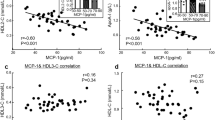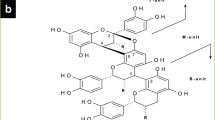Abstract
Curcumin affects the functions of adipocytes. But it is not known whether curcumin has some effect on the cholesterol efflux process of adipocytes. Rabbit subcutaneous adipocytes were incubated with 5, 10 and 20 μg/ml curcumin for 24 h. The cholesterol efflux onto apoAI was assessed, and the peroxisome proliferators-activated receptor (PPAR) γ, liver X receptor (LXR) α and ATP-binding cassette transporter A1 (ABCA1) mRNA expression in adipocytes were quantified by reverse-transcription polymerase chain reaction (RT-PCR). Curcumin increased the cholesterol efflux from adipocytes in dose-dependent manner. The increased expression of PPARγ, LXRα and ABCA1 caused by curcumin were parallel. When the adipocytes were pre-treated by GW9662, the increased expression of PPARγ induced by curcumin was partially prevented, subsequent to the down-regulation of LXRα and ABCA1. Curcumin can affect the cholesterol efflux from adipocytes by regulating the PPARγ-LXR-ABCA1 passway.



Similar content being viewed by others
References
Galic S, Oakhill JS, Steinberg GR (2010) Adipose tissue as an endocrine organ. Mol Cell Endocrinol 316:129–139
Rasouli N, Kern PA (2008) Adipocytokines and the metabolic complications of obesity. J Clin Endocrinol Metab 93:64–73
Hajer GR, van Haeften T, Visseren FL (2008) Adipose tissue dysfunction in obesity, diabetes, and vascular diseases. Eur Heart J 29:2959–2971
Le LS, Ferre P, Dugail I (2004) Adipocyte cholesterol balance in obesity. Biochem Soc Trans 32:103–106
Yvan-Charvet L, Bobard A, Bossard P et al (2007) In vivo evidence for a role of adipose tissue sr-bi in the nutritional and hormonal regulation of adiposity and cholesterol homeostasis. Arterioscler Thromb Vasc Biol 27:1340–1345
Zhang Y, McGillicuddy FC, Hinkle CC, O’Neill S, Glick JM, Rothblat GH, Reilly MP (2010) Adipocyte modulation of high-density lipoprotein cholesterol. Circulation 121:1347–1355
Zhao SP, Wu ZH, Hong SC, Ye HJ, Wu J (2006) Effect of atorvastatin on sr-bi expression and hdl-induced cholesterol efflux in adipocytes of hypercholesterolemic rabbits. Clin Chim Acta 365:119–124
Ejaz A, Wu D, Kwan P, Meydani M (2009) Curcumin inhibits adipogenesis in 3t3–l1 adipocytes and angiogenesis and obesity in c57/bl mice. J Nutr 139:919–925
Howard AD, Verghese PB, Arrese EL, Soulages JL (2010) Characterization of apoa-i-dependent lipid efflux from adipocytes and role of abca1. Mol Cell Biochem 343:115–124
Tall AR, Yvan-Charvet L, Terasaka N, Pagler T, Wang N (2008) Hdl, abc transporters, and cholesterol efflux: implications for the treatment of atherosclerosis. Cell Metab 7:365–375
Jacob A, Wu R, Zhou M, Wang P (2007) Mechanism of the anti-inflammatory effect of curcumin: ppar-gamma activation. PPAR Res 2007:89369
Kang Q, Chen A (2009) Curcumin inhibits srebp-2 expression in activated hepatic stellate cells in vitro by reducing the activity of specificity protein-1. Endocrinology 150:5384–5394
Wang HM, Zhao YX, Zhang S et al (2010) Ppargamma agonist curcumin reduces the amyloid-beta-stimulated inflammatory responses in primary astrocytes. J Alzheimers Dis 20:1189–1199
Li AC, Binder CJ, Gutierrez A et al (2004) Differential inhibition of macrophage foam-cell formation and atherosclerosis in mice by pparalpha, beta/delta, and gamma. J Clin Invest 114:1564–1576
Costet P, Luo Y, Wang N, Tall AR (2000) Sterol-dependent transactivation of the abc1 promoter by the liver x receptor/retinoid x receptor. J Biol Chem 275:28240–28245
Wagner BL, Valledor AF, Shao G et al (2003) Promoter-specific roles for liver x receptor/corepressor complexes in the regulation of abca1 and srebp1 gene expression. Mol Cell Biol 23:5780–5789
Chawla A, Boisvert WA, Lee CH et al (2001) A ppar gamma-lxr-abca1 pathway in macrophages is involved in cholesterol efflux and atherogenesis. Mol Cell 7:161–171
Wu ZH, Zhao SP (2009) Niacin promotes cholesterol efflux through stimulation of the ppargamma-lxralpha-abca1 pathway in 3t3–l1 adipocytes. Pharmacology 84:282–287
Zhao SP, Dong SZ (2008) Effect of tumor necrosis factor alpha on cholesterol efflux in adipocytes. Clin Chim Acta 389:67–71
Peschel D, Koerting R, Nass N (2007) Curcumin induces changes in expression of genes involved in cholesterol homeostasis. J Nutr Biochem 18:113–119
Tang Y, Zheng S, Chen A (2009) Curcumin eliminates leptin’s effects on hepatic stellate cell activation via interrupting leptin signaling. Endocrinology 150:3011–3020
Lin J, Chen A (2008) Activation of peroxisome proliferator-activated receptor-gamma by curcumin blocks the signaling pathways for pdgf and egf in hepatic stellate cells. Lab Invest 88:529–540
Zheng S, Chen A (2004) Activation of ppargamma is required for curcumin to induce apoptosis and to inhibit the expression of extracellular matrix genes in hepatic stellate cells in vitro. Biochem J 384:149–157
Lee YK, Lee WS, Hwang JT, Kwon DY, Surh YJ, Park OJ (2009) Curcumin exerts antidifferentiation effect through ampkalpha-ppar-gamma in 3t3–l1 adipocytes and antiproliferatory effect through ampkalpha-cox-2 in cancer cells. J Agric Food Chem 57:305–310
Kuroda M, Mimaki Y, Nishiyama T et al (2005) Hypoglycemic effects of turmeric (curcuma longa l. Rhizomes) on genetically diabetic kk-ay mice. Biol Pharm Bull 28:937–939
Narala VR, Smith MR, Adapala RK et al (2009) Curcumin is not a ligand for peroxisome proliferator-activated receptor-gamma. Gene Ther Mol Biol 13:20–25
Wang SL, Li Y, Wen Y, Chen YF, Na LX, Li ST, Sun CH (2009) Curcumin, a potential inhibitor of up-regulation of tnf-alpha and il-6 induced by palmitate in 3t3–l1 adipocytes through nf-kappab and jnk pathway. Biomed Environ Sci 22:32–39
Singh S, Aggarwal BB (1995) Activation of transcription factor nf-kappa b is suppressed by curcumin (diferuloylmethane) [corrected]. J Biol Chem 270:24995–25000
Chen M, Li W, Wang N, Zhu Y, Wang X (2007) Ros and nf-kappab but not lxr mediate il-1beta signaling for the downregulation of atp-binding cassette transporter a1. Am J Physiol Cell Physiol 292:1493–1501
Ferreira V, van Dijk K, Groen AK et al (2007) Macrophage-specific inhibition of nf-kappab activation reduces foam-cell formation. Atherosclerosis 192:283–290
Gerbod-Giannone MC, Li Y, Holleboom A, Han S, Hsu LC, Tabas I, Tall AR (2006) Tnfalpha induces abca1 through nf-kappab in macrophages and in phagocytes ingesting apoptotic cells. Proc Natl Acad Sci USA 103:3112–3117
Huwait EA, Greenow KR, Singh NN, Ramji DP (2011) A novel role for c-jun n-terminal kinase and phosphoinositide 3-kinase in the liver x receptor-mediated induction of macrophage gene expression. Cell Signal 23:542–549
Acknowledgments
We thank Professor Jianfang Chen for cholesterol assays. Professor Chen is an investigator of the Nuclear Medicine Laboratory of Xiang Ya Medical College at the Central South University.
Author information
Authors and Affiliations
Corresponding author
Rights and permissions
About this article
Cite this article
Dong, Sz., Zhao, Sp., Wu, Zh. et al. Curcumin promotes cholesterol efflux from adipocytes related to PPARgamma–LXRalpha–ABCA1 passway. Mol Cell Biochem 358, 281–285 (2011). https://doi.org/10.1007/s11010-011-0978-z
Received:
Accepted:
Published:
Issue Date:
DOI: https://doi.org/10.1007/s11010-011-0978-z




